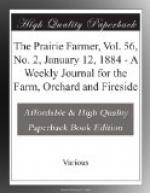Professor Stockbridge, in 1879, at the Massachusetts Agricultural College, carried on very valuable and full experiments in test of this general belief, and arrived at results contradictory of this belief. He found, in a multitude of tests, that in every instance, save one, for the months from May to November, that the surface soil from one to five inches deep, was warmer than the air instead of cooler, as the law requires for condensation of moisture from the air. That exception was in the center of a dense forest, under peculiar atmospheric conditions. After noting these facts, ingenious methods were employed to test more directly the proposition that soil gains moisture from the air by night, with the result that he announced that soils lose moisture by night. Professor Stockbridge’s efforts met with some criticism, and his conclusions did not receive the wide acceptance that his view of the question justifies. In reasoning from observation, Professor Stockbridge noted that the bottom of a heap of hay, during harvesting, would be wet in the morning, the under side of a board wet in the morning, and so of the other objects named. In the progress of tillage experiments related in his Bulletins Nos. 3 and 5, Prof. Sanborn’s attention was again called to this question, resulting in the prosecution of direct tests of the soil moisture itself. When completed it is thought that there will then no longer be occasion to reason from assumed premises regarding the matter. The trials were begun late, and under disadvantages; and are to be understood as preliminary to more complete tests during 1884. The experiments were all conducted upon a soil bare of vegetation.
Prof. Sanborn concludes from his experiments thus far that the surface gains moisture from soil beneath it by capillary action, but gathers nothing from the air. This is made strongly probable, if not shown; first, because the soil is warmer by night than the air. (He relies upon other facts than his own for this assertion.) 2nd. Because he found more moisture in the soil when covered over night than when left bare. 3d. Because when hoed, thereby disturbing capillary action, he found less moisture than when unhoed, in surface soil. Finally, he concludes the position proven, for, when he shut off the upward flow of water to the surface of the soil, he found not only less moisture above the cut off or in the surface soil than where no disturbance of capillary action had been made, but actually less moisture in the surface soil than the night before. Strongly corroborating this conclusion is the fact that all of the tests conspire to show that the gain of moisture in the surface of the soil by night is traceable to one source, and only one source.
[Illustration: American ash.—See Page 25.]
The facts of this bulletin accord with the previous ones in showing that mulching and frequent shallow tillage economize the moisture of the soil and add new proof of this to those already given.




